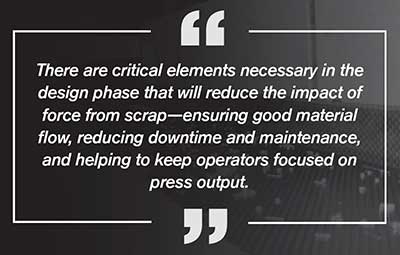
“There are critical elements necessary in the design phase that will reduce the impact of force from scrap- ensuring good material flow, reducing downtime and maintenance, and helping to keep operators focused on press output.” –Bob Anspaugh, conveyor sales engineer for PRAB Inc.
Q: Why a steel belt for metal stamping scrap?
A: As press technology has expanded to meet the changing demands of customers in the automotive, aerospace, defense, and construction equipment sectors, the reliability and robust nature of the steel belt conveyor design remains one of the most efficient methods for the transfer of flat metal stamping scrap.
Q: Aren’t all under press steel belt conveyors the same? Why does the design matter?
A: The design of the steel belt conveyor for a given application is a critical component to maximum asset utilization and decreased costs by avoiding conveyor wear and unplanned downtime. The increased demands on stampers to achieve tighter tolerances using a wider range of materials coupled with 24/7 run times means that equipment purchases normally made as second nature now need to be evaluated for dependability and longevity under extreme operating conditions.

Q: How does the force from falling scrap effect the life of the conveyor?
A: The structural and functional design of a press is focused on the operating process and the quality of the output-how and where the scrap is collected and disposed of is typically not part of the design process. This reality can pose challenges when stamping operations purchase conveyors for moving their scrap.
When stamping scrap is discharged from the press it can fall from 36 inches up to more than 10 ft. The impact of this drop can be significant on the conveyor belt reducing the reliability and increasing maintenance.
To understand the implications of the scrap falling on the conveyor belt, we can use a typical formula for “Impact Force of a Falling Object.” While there are other application specific variables that can be added to this calculation, the basic equation helps to see the exponential impact of force.
An example as a result of one specific calculation, was finding that the impact of a piece of scrap weighing 1.2 lbs. had 460 lbs. of force on the conveyor belt. “Ouch!” In this case, the conveyor belt was assumed to deflect 1/8” under impact-repetitive high force impacts of this type explain the potential for premature conveyor failure.
To illustrate the impact of force, consider the effect of an air bag in an automobile. In a crash test simulation without an air bag, a crash dummy hits the windshield with high force. The addition of the air bag reduces the effects of the force because the air bag lengthens the stopping time and distance and absorbs a portion of the generated force.
Q: What design solutions are available?
A: Engineers and plant managers looking to get the most out of their conveyors can work to reduce the effects of impact force on the conveyor. One approach is to slow the scrap down with chute. The other method is to design the belt more resistant to impact of the scrap. There are several additional solutions that can be put in place to get the most life out of the conveyor and they should be discussed in the design phase, before build and installation.
Q: What should I know from the supplier when looking for the right solution?
A: Understanding the impact of force from metal scrap falling from a press on to a steel belt conveyor is important to know during the design and quotation phase of a new conveyor purchase. There are some core design elements that can be built into a specific steel belt conveyor that will not only reduce the effects of force, but also improve material flow. Both elements will reduce unplanned downtime and maintenance costs and will help to keep your focus on press output.